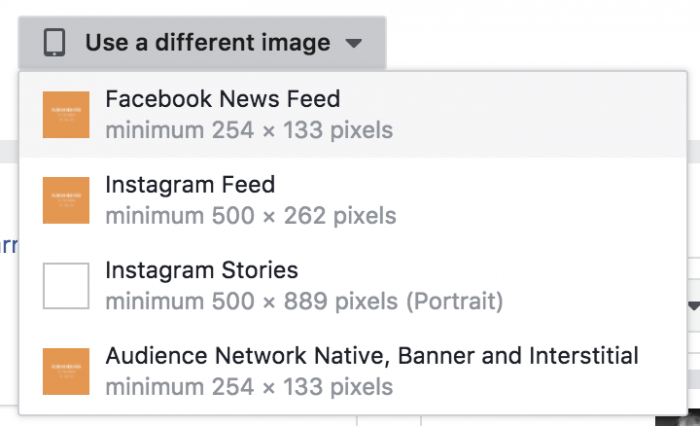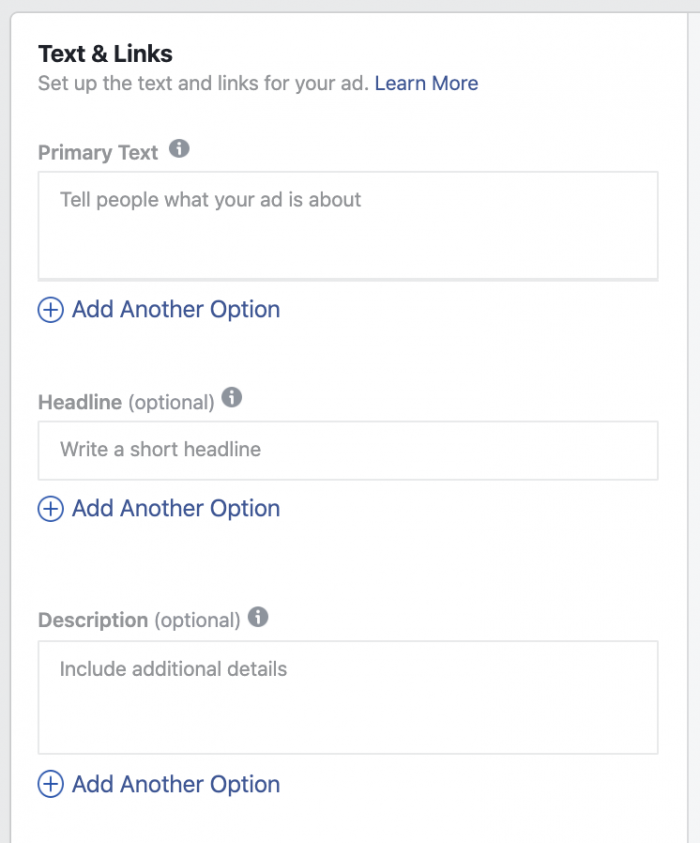There was a time when Fb advertisers had near-total management over how their advertisements appeared. A single advert consisted of:
- One picture or video
- One major textual content
- One headline
- One description
There have been no facet ratio variations by placement. One dimension (normally 1.91:1, however it trusted the advert kind) was used in all places. In the event you wished to indicate a distinct model of an advert for a placement, you needed to create a separate advert set and advert for it.
Due to this straightforward building, advertisers had a transparent imaginative and prescient of what did and didn’t work. They’d create totally different advertisements to check mixtures of advert copy and artistic. That they had management.
This setup made sense within the early years of Fb promoting. However as placements multiplied and automation developed, sustaining that stage of management grew to become tough, if not unattainable.
Most advertisers haven’t tailored. They nonetheless strategy advert copy and artistic as in the event that they each require and retain that stage of management. However the actuality could be very totally different.
The Early Period of Simplicity (Pre-2017)
In 2013 and 2014, advertisers had a restricted set of placements:
- Desktop Information Feed
- Cellular Information Feed
- Proper Column on Desktop
- Proper Column on Cellular
Right here’s a screenshot from Energy Editor that reveals how we chosen placements again then…

That was it. There was no use for variations, and Meta didn’t provide the power to customise by placement. A single asset was used in all places.
By late 2017, issues had began to change into a bit extra sophisticated. There have been 12 official placements…
Fb:
- Feeds
- Immediate Articles
- In-Stream Movies
- Proper Column
- Recommended Movies
Instagram:
Viewers Community:
- Native, Banner and Interstitial
- In-Stream Movies
- Rewarded Movies
Messenger:
This enlargement pushed advertisers to assume extra broadly. The advert creation instruments nonetheless revolved round fastened mixtures, except you have been prepared to construct every advert manually for each placement.
Even with 12 placements, a single advert nonetheless represented one mixture of advert copy and artistic. No variations.
The First Wave of Automation (2017–2019)
In 2017, Meta launched Dynamic Artistic, permitting advertisers to submit as much as 30 artistic parts for a single advert:
- 10 photos or movies
- 5 major textual content choices
- 5 headlines
- 5 descriptions
- 5 CTA buttons
Meta would mechanically combine and match these to search out the best-performing mixtures. This was non-obligatory and largely handled as a testing device (rightly or wrongly). The default advert creation stream nonetheless centered on a single mixture of artistic, major textual content, headline, and outline.
Later that yr, advertisers got the power to customise artistic by placement for the primary time.

Advertisers now not wanted to make use of the identical picture or copy throughout all placements. This transformation eradicated the necessity to create separate advertisements for every placement simply to make use of totally different visuals or textual content.
In 2019, Meta added A number of Textual content Choices, taking a characteristic from Dynamic Artistic and making use of it extra broadly.

This allowed advertisers to submit as much as 5 variations of major textual content, headlines, and descriptions for Visitors, App Installs, and Conversions targets. The management hole started to widen: You possibly can nonetheless present particular inputs, however Meta was doing extra of the meeting.
The Present Panorama (2025)
Right this moment, the concept of “management” seems to be very totally different. You continue to submit components, however the ultimate output is way much less predictable, and much more assorted.
Right here’s why:
1. There are 26 placements, every with totally different structure guidelines, textual content limits, and artistic remedies.
2. Advertisers are inspired to submit three facet ratios for picture and video property to suit placement teams of 1:1, 9:16, and 1.91:1.
3. You possibly can nonetheless customise advert copy and artistic by placement (and it’s best to for optimum outcomes).
4. Advertisers can manually submit as much as 5 variations of major textual content, headlines, and descriptions.
5. Meta might advocate or auto-generate an further 5 variations of every textual content subject utilizing AI that advertisers can apply.
6. If Benefit+ Artistic is enabled, Meta can apply a number of artistic enhancements mechanically. Optionally available enhancements for single picture and video advertisements embody:
- Regulate brightness and distinction
- Present merchandise
- Add particulars to advert structure
- Add overlays
- Add dynamic overlays
- Improve CTA
- Increase picture
- Picture animation
- Music
- Related feedback
- Retailer areas
- Textual content enhancements
- Video results
- Video enlargement
- Visible touch-ups
- 3D animation
- Add web site hyperlinks
All of those generate further variations of your advertisements.
The outcome? A single advert is now not a clearly outlined unit. As a substitute, it’s a group of copy, photos, movies, and AI-enhanced variations that Meta assembles dynamically, relying on the person, placement, gadget, and extra.
An advert now not represents a single, outlined mixture. It could actually now contain lots of, if not 1000’s, of prospects.
From Inputs to Ecosystem
What was once a easy, clearly outlined artistic determination is now a branching ecosystem:
1. You present inputs (textual content, photos, movies).
2. Meta builds mixtures (handbook or AI-assisted).
3. Meta renders these mixtures otherwise throughout as much as 26 placements.
4. Enhancements might alter these mixtures additional.
Your submitted advert turns into certainly one of many potential variations. What customers see relies upon much less on what you submitted and extra on how Meta’s programs interpret, optimize, and ship it.
Your “advert” is now not a clearly outlined set of parts. It’s now a group of property, or “advert items,” that may be mixed to create limitless variations of your advert in order that the appropriate model may be proven to the appropriate individual in the appropriate location on the proper time.
In some ways, the fashionable “advert” behaves extra like how we perceived the advert set.
The New Position of the Advertiser
The issue is that Many advertisers nonetheless strategy their function in advert creation as if it’s a pre-2017 world the place an advert is clearly outlined. However the surroundings is way totally different now, and so is your function.
Right this moment, your job isn’t to dictate precisely what the advert seems to be like. As a substitute, it’s to offer high-quality components.
Which means:
1. Writing copy that’s versatile, compelling, and modular.
2. Supplying artistic that works throughout codecs and facet ratios.
3. Understanding that your inputs could also be swapped, trimmed, enhanced, or reassembled.
Management hasn’t disappeared, however it’s shifted. You’re now not controlling the ultimate output. You’re shaping the potential paths Meta’s system can take.
And on this new period, embracing that shift is what separates outdated advertisers from those that thrive throughout the platform’s ever-evolving ecosystem.
How This Impacts Artistic Testing
This evolution of an advertiser’s function within the meeting of advert copy and artistic ends in uncertainty, which makes advertisers uncomfortable. It may additionally imply a shift in how we strategy artistic testing.
When we have now full management over variables and variations, it is smart to isolate one of the best mixture of advert copy and artistic to optimize outcomes. That was straightforward to do since an advert mirrored a single mixture.
However that’s not true now. Since a single advert is the mix of lots of or 1000’s of mixtures and variables, the previous guidelines of “discovering a successful mixture” now not apply in the identical approach. A single, efficient advert is a group of many successful mixtures.
That doesn’t imply that you just ignore the outcomes for particular person advert copy and artistic variations, although I counsel that ends in mixture makes much more sense now. However as an alternative of micromanaging outcomes based mostly on this data, we study from them and apply these changes to future advertisements.
Your Flip
Something you’d add to how an advertiser’s function with advert copy and artistic has developed?
Let me know within the feedback under!



